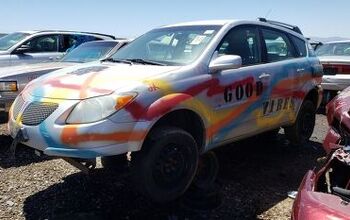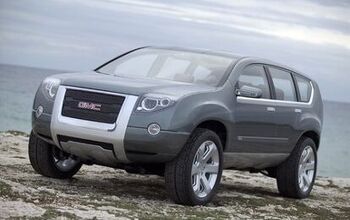General Motors Death Watch 162: Cannibals
Back in the eighties, a GM executive congratulated a colleague who worked for the Cadillac brand. “Well done for reaching 300k sales.” The Caddy man was having none of it. “We didn’t sell three hundred thousand Cadillacs; we sold three hundred thousand Buicks.” The remark was prescient in two ways. First, it acknowledged Cadillac’s ruinous move “down market.” Second, more importantly, it reflected the fact that Caddy’s success was Buick’s failure. GM was already descending from a well-ordered familial hierarchy into the madness and chaos of cannibalism.
Alfred P. Sloan’s motto “a car for every purse and purpose” established the framework for this descent. Sloan encouraged GM customers to work their way up from cheaper to more expensive brands. When GM’s brand delineations were rigid, when there was a steady supply of customers at the bottom of the ladder, the system worked beyond Sloan’s wildest dreams. GM was the world’s biggest carmaker AND the planet’s most profitable company.
Today, GM’s overlapping brand and product portfolio has rendered Sloan’s system meaningless. GM’s eight brands compete with each other for business with similar if not virtually identical products. Saturn Aura, Chevy Malibu or Saab 9-3? Chevy Traverse or Saturn Outlook? Or GMC Acadia?
Honda killed the Prelude when the S2000 came out, then killed the RSX when the Civic went up-market. Toyota killed the Celica when the Scion-tC arrived. While all of these cuts had something to do with lowered sales, they were more about preventing cannibalism. Conversely, GM doesn’t seem to want to cut anything.
GM’s CUVs are selling reasonably enough, but their SUVs are still out there, somewhere. As GM’s shrinking market share proves, their CUV sales haven’t been anywhere near large enough to compensate for the drop in “traditional” trucks. Even if they were, GM’s unibody CUVs are more expensive to produce than their body-on-frame predecessors. Downsizing customers are downsizing GM’s profit margins, Big Style.
On the face of it, this CUV on SUV cannibalization seems logical and unavoidable. GM’s SUV customers are abandoning the genre anyway, so why not keep them “in the family?” Better some profit than none. But the counter-argument is far more compelling. Overlapping products dilute or destroy the central brand message. Product development and marketing resources are spread paper thin. This kind of cannibalism makes its practitioners weak, and lazy.
New vehicles always draw customers away from rival products. The cars that suffer the most are the least “competitive” in or near that market segment. Unfortunately for GM, they often own both the next big thing AND the tired old timer. Note how the Malibu push mirrors the Impala’s fall. And the Saturn Aura’s. And the Pontiac G6’. And God knows what else.
Sadly, GM executives seem completely oblivious to the problem. The new CTS may be a hit product, but no one in the organization seems to have stopped and considered the fact the bright shiny newcomer will consume Caddy customers who may have (for some reason of other) hankered for a pricier DTS or STS. By the same token, the rear wheel-drive (RWD) Pontiac G8 could well be an exciting ride, but if it’s too exciting, it could steal sales from both the (RWD) CTS and the now po-faced front wheel-drive G6. And God knows what else.
Dealers are active conspirators in all this. Whenever a hot product appears at a rival brand, they demand a “tit for tat” version. This leads to badge-engineering, which further divides the sales pool, which ensures that any successful new car will eat its “father” (or uncle) first. It’s a vicious circle that dooms all its participants to eternal feast and famine.
As GM’s recent history proves, there will always be a “bright spot” in the bigger, bleaker picture. Some vehicle will always be relatively healthy– as it feasts on its predecessors, ancestors and weaker siblings. The success of a new model builds executive careers down at RenCen, but it does the company no good. With GM’s lack of build flexibility, the automaker ends-up overworking 25 percent of its plants while idling another 25 percent somewhere else.
GM’s not the only example of auto industry cannibalism. Chrysler’s four-door Wrangler has been eating away at the Liberty, while the Compass, Nitro and Patriot all nibble on each other as they vie for the same sort of customers. VW has some issues in the US market (bumping into Audi) and much worse ones back in Europe (SEAT/Skoda). But GM is crazy with cannibals.
There is but one way to end this misery. GM must either return to the kind of rigid brand/product discipline of Sloan’s day, or declare bankruptcy (to void dealer power), kill all but two or three brands and THEN return to the kind of rigid brand/product discipline of Sloan’s day. There is no other alternative.
More by Andrew Dederer
Latest Car Reviews
Read moreLatest Product Reviews
Read moreRecent Comments
- Teddyc73 Doesn't matter, out of control Democrats will still do everything they can to force us to drive them.
- Teddyc73 Look at that dreary lifeless color scheme. The dull grey and black wheels and trim is infecting the auto world like a disease. Americans are living in grey houses with grey interiors driving look a like boring grey cars with black interiors and working in grey buildings with grey interiors. America is turning into a living black and white movie.
- Jalop1991 take longer than expected.Uh-huh. Gotcha. Next step: acknowledging that the fantasies of 2020 were indeed fantasies, and "longer than expected" is 2024 code word for "not gonna happen at all".But we can't actually say that, right? It's like COVID. You remember that, don't you? That thing that was going to kill the entire planet unless you all were good little boys and girls and strapped yourself into your living room and never left, just like the government told you to do. That thing you're now completely ignoring, and will now deny publicly that you ever agreed with the government about.Take your "EV-only as of 2025" cards from 2020 and put them in the same file with your COVID shot cards.
- Jalop1991 Every state. - Alex Roy
- CanadaCraig My 2006 300C SRT8 weighs 4,100 lbs. The all-new 2024 Dodge Charge EV weighs 5,800 lbs. Would it not be fair to assume that in an accident the vehicles these new Chargers hit will suffer more damage? And perhaps kill more people?


































Comments
Join the conversation
Ummmm, I'm not convinced that Toyota is the example of whom to follow in terms of not cannibalizing. Let's see, the Highlander is Toyota's midsized SUV. Just like the RAV4. Just like the 4Runner, and I guess the FJ Cruiser, which are a little tougher. And also the RX350, which has leather, and the GX470 which has leather too. And the LandCruiser, and the LX470, again with the leather. But you can get a Highlander with leather too, it just costs more. Yes, I know, they are all a just a little bit different. But not that much, really.